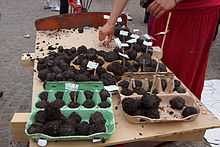Seed bombing

Seed bombing or aerial reforestation[1] is a technique of introducing vegetation to land by throwing or dropping compressed bundles of soil containing live vegetation (seed balls). Often, seed bombing projects are done with arid or off-limits (for example, privately owned) land.
History
The term "seed grenade" was first used by Liz Christy in 1973 when she started the "Green Guerrillas". The first seed grenades were made from balloons filled with tomato seeds, and fertilizer.[2] They were tossed over fences onto empty lots in New York City in order to make the neighborhoods look better. It was the start of the guerrilla gardening movement.
'The earliest records of aerial reforestation date back from 1930. In this period, planes were used to distribute seeds over certain inaccessible mountains in Honolulu after forest fires.[1]
Seed bombing is also widely used in Africa; where they are put in barren or simply grassy areas. With technology expanding, the contents of a seed bomb are now placed in a biodegradable container and "bombed" grenade-style onto the land. As the sprout grows, the container biodegrades into the soil. The process is usually done as a large-scale project with hundreds dropped in a single area at any one time. Provided enough water, adequate sunlight, and low competition from existing flora and fauna, seed-bombed barren land could be host to new plants in as little as a month.
In 1987, Lynn Garrison created the Haitian Aerial Reforestation Project (HARP) in which tons of seed would be scattered from specially modified aircraft. The seeds would be encapsulated in an absorbent material. This coating would contain fertilizer, insecticide/animal repellent and, perhaps a few vegetable seeds. Haiti has a bimodal rainy season, with precipitation in spring and fall. The seeds are moistened a few days before the drop, to start germination. Tons of seed can be scattered across areas in the mountains, inaccessible to hand-planting projects.
Another project idea was to use C-130 aircraft and altering them to drop biodegradable cones filled with fertilizer and saplings over hard-to-access areas.[3]
See also
- Miss Rumphius, a 1982 children's book emphasizing public seed scattering
- Seed dispersal
- Johnny Appleseed
- Diggers
References
- ↑ 1.0 1.1 Horton, Jennifer. "Could military strategy win the war on global warming?". How Stuff Works. Retrieved 2012-04-06.
- ↑ "How Guerrilla Gardening Works". How Stuff Works. Retrieved 2012-08-14.
- ↑ Brown, Paul (1999-09-02). "Aerial bombardment to reforest the earth". The Guardian. Retrieved 2011-06-09.
Further reading
- Smith, K. (2007). The guerilla art kit. Princeton Architectural Press.
- Huxta, B. (2009). Garden-variety graffiti. Organic gardening, 2009.
External links
- http://www.stuffyoushouldknow.com/podcasts/how-guerrilla-gardening-works/
- http://www.wikihow.com/Make-a-Seed-Bomb
- http://www.latimes.com/news/local/la-hm.0529.seedbomb-pg,0,4073581.photogallery#axzz2im1rw4UK
- http://www.gardenista.com/posts/diy-wildflower-seed-bombs
- http://articles.washingtonpost.com/2012-04-14/lifestyle/35454538_1_guerrilla-gardeners-garden-store-social-justice
- http://www.permanentculturenow.com/guerrilla-gardening/
- http://news.bbc.co.uk/2/hi/uk_news/scotland/8548005.stm
- http://www.npr.org/2006/05/29/5435131/tending-defiant-gardens-during-wartime
- http://news.bbc.co.uk/2/hi/special_report/1999/02/99/e-cyclopedia/720544.stm
- http://www.theguardian.com/environment/blog/2011/apr/11/seed-bombs-derelict-land-flowers
- UK Seed Bomb Supplier, Seed Freedom
- The guerrilla gardener's seedbomb recipe
- Planning an Effective Seed Bomb Strike